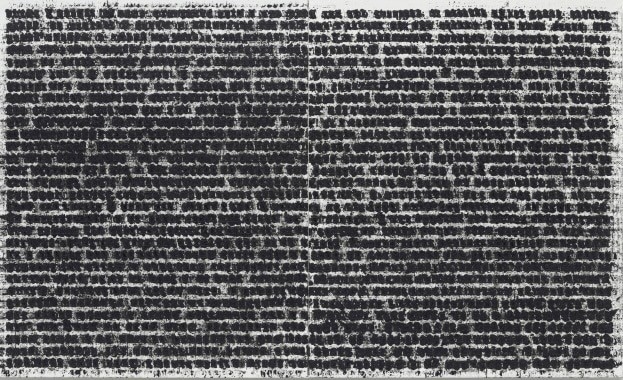
Glenn Ligon DOUBLE NEGATIVE
With DOUBLE NEGATIVE, Glenn Ligon’s seventh exhibition at Regen Projects, the artist points to the work and all the reading (and reads) he has already traced in essays like “Black Light: David Hammons and the Poetics of Emptiness,” an essay in seven segments that appeared in the September 2004 issue of Artforum—and artworks—particularly the paintings he has inscribed with passages from James Baldwin’s 1953 essay, “Stranger in the Village,” a series that began in 1996. Whereas Baldwin’s text has appeared in parts, passages, and selections in those earlier works, it unfolds here in full across eighteen panels coupled as nine diptychs, affording what Ligon describes as “the ground on which the painting is sited.”
As if to deny or redact what has already been disclosed, X’s appear across the nine diptychs presented here, in-line, atop the essay and then more freely. Complicating the legibility of Baldwin’s words, the X’s push toward abstraction and create new meanings. The X proffers the possibility of excision or negation. To cross or x out is a literal embodiment of a familiar colloquialism presented en masse. And yet, Ligon courts its capacity to create perhaps more than evacuate meaning— recalling various forms of asemic writing, concrete poetry, and artistic touchstones including Henri Michaux, Norman Lewis, and Cy Twombly. A fundamental mark, the X arises even when other writing systems are absent, as in the use of the X to denote a signature. It also suggests political action, alluding to figures such as Malcolm X, whose adopted surname replaced one tied to a legacy of white supremancy.
In a 2021 profile of the artist for T: The New York Times Style Magazine, Megan O’Grady observed that, “Ligon has in many ways inherited Baldwin’s mantle to become the foremost philosopher on race and identity in America.” Ligon’s pictures of Baldwin’s words are worth, and bear, repeating. Underscoring the difference ushered in by every mark made, Ligon’s DOUBLE NEGATIVE imagines a perpetual or generational conversation, a spectral call-and-response between Ligon, Baldwin, and innumerable others that exceeds language as we know it.
Glenn Ligon (b. 1960) earned a BA from Wesleyan University in 1982, and attended the Whitney Museum’s Independent Study Program in 1985. He lives and works in New York, NY.
Solo exhibitions of Ligon’s work have been presented at Carré d’Art, Nîmes (2022); Camden Art Centre, London (2014–15); Whitney Museum of American Art, New York (2011); The Power Plant, Toronto (2005); The Studio Museum in Harlem, New York (2001); Kunstverein München (2001); Walker Art Center, Minneapolis (2000–2001); and the Institute of Contemporary Art, University of Pennsylvania, Philadelphia (1998). Ligon’s work was included in two editions of the Venice Biennale (1997 and 2015), documenta11 (2002), and two editions of the Whitney Biennial (1991 and 1993). His recent curatorial projects include Grief and Grievance: Art and Mourning in America, New Museum, New York (2021); Blue Black, Pulitzer Arts Foundation, St. Louis (2017); and Encounters and Collisions, Nottingham Contemporary, which traveled to Tate Liverpool (2015). A forthcoming curatorial project entitled Glenn Ligon: All Over The Place, will be presented at the Fitzwilliam Museum, University of Cambridge in 2024.
Ligon was elected a member of the American Academy of Arts and Letters in 2021, and has received numerous awards and recognitions for his work, including a Smithsonian Institution Archives of American Art Medal (2017); the Visual AIDS Vanguard Award (2016); the Studio Museum in Harlem’s Joyce Alexander Wein Artist Prize (2009); the Skowhegan Medal for Painting (2006); a John Simon Guggenheim Memorial Foundation Fellowship (2003); and a Joan Mitchell Foundation Fellowship (1997).
Monographs and publications on his work include Untitled (America)/Debris Field/Synecdoche/Notes for a Poem on the Third World (Regen Projects, 2019); Glenn Ligon: Debris Field/Notes for a Poem on the Third World/Soleil Nègre (Galerie Chantal Crousel and Is-Land edition, 2018); Blue Black (Pulitzer Arts Foundation, 2017); Glenn Ligon: A People on the Cover (Ridinghouse, 2015); Glenn Ligon: Encounters and Collisions (Tate Publishing, 2015); Glenn Ligon: AMERICA (Whitney Museum of American Art, 2011); Yourself in the World: Selected Writings and Interviews (Yale University Press, 2011); Glenn Ligon: Some Changes (The Power Plant, 2005); Stranger (Studio Museum in Harlem, 2001); Coloring: New Work by Glenn Ligon (Walker Art Center, 2001), and Glenn Ligon: Unbecoming (Institute of Contemporary Art, University of Pennsylvania, 1998). A forthcoming publication is scheduled for release by Phaidon in 2024, along with Distinguishing Piss from Rain: Selected Writings and Interviews (Hauser & Wirth Publishers), also in 2024.
Ligon’s work is held in the permanent collections of museums worldwide including Art Institute of Chicago; The Broad, Los Angeles; Centre Georges Pompidou, Paris; Dallas Museum of Art; Detroit Institute of Arts; Guggenheim Museum, New York; Hammer Museum, Los Angeles; Hirshhorn Museum and Sculpture Garden, Washington, D.C.; Los Angeles County Museum of Art; Museum of Contemporary Art Chicago; Museum of Contemporary Art, Los Angeles; Museum of Modern Art, New York; National Gallery of Art, Washington, D.C.; Philadelphia Museum of Art; San Francisco Museum of Modern Art; The Studio Museum in Harlem; Tate Modern, London; Walker Art Center, Minneapolis, and Whitney Museum of American Art, New York, among others.